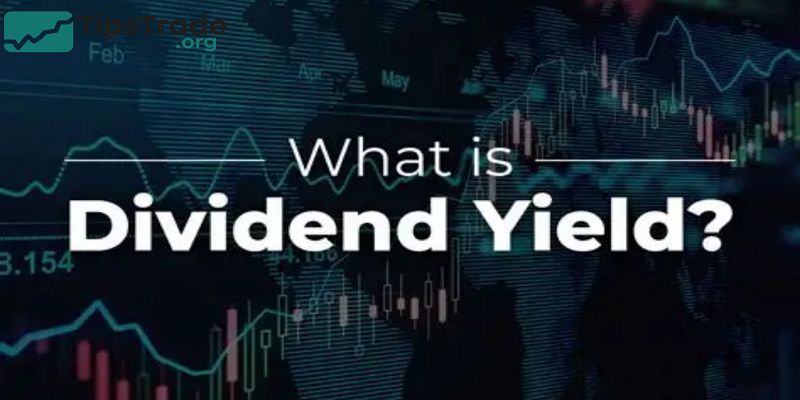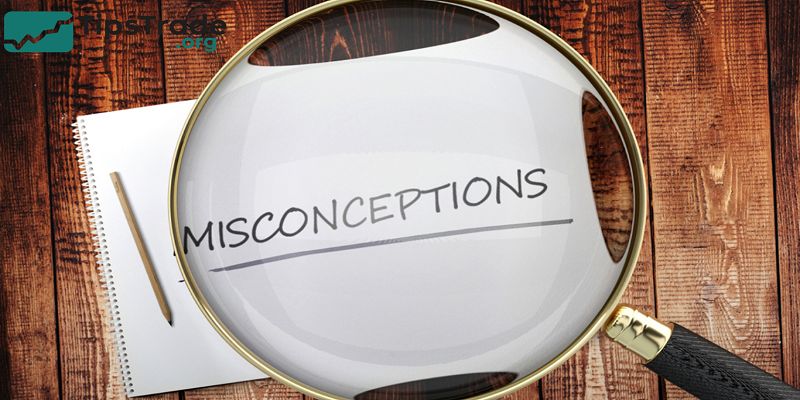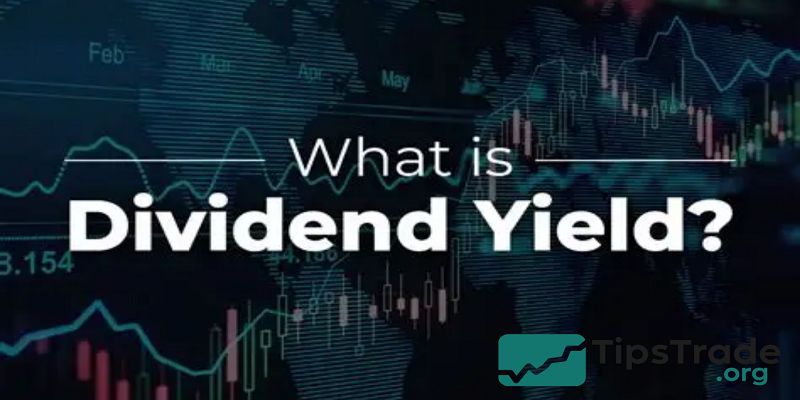Dividend yield is one of the most widely used financial metrics for evaluating income-generating stocks. Instead of relying only on price growth, investors who focus on dividend yield aim to build steady cash flow from their portfolios. The concept is simple: companies share a portion of their earnings with shareholders in the form of dividends, and the dividend yield shows how much return an investor receives relative to the stock price. Throughout this article, readers will learn what dividend yield means, how to calculate it, the advantages and risks of high dividend yield stocks, and how investors use this metric to build a balanced investment strategy. Visit tipstrade.org and check out the article below for further information
What Is Dividend Yield?

Dividend yield is a financial ratio that shows how much a company pays in dividends each year relative to its share price. It allows investors to measure the return they receive from dividends, separate from capital gains.
For example, if a company pays $4 in annual dividends and its stock price is $100, the dividend yield is 4%. This makes it easier for investors to compare income opportunities across different industries, companies, or asset classes. According to corporate finance guidelines commonly referenced by Nasdaq and Investopedia, dividend yield is considered a key indicator for evaluating stocks with stable earnings and long-term profitability.
Companies with reliable dividend payments usually operate in mature industries such as consumer goods, banking, telecommunications, or utilities. These businesses tend to generate predictable cash flows, which allows them to distribute earnings consistently. Because of this, dividend yield is often viewed as a sign of financial stability.
However, investors should not rely on it alone—dividend yield must be analyzed alongside fundamentals such as revenue growth, debt levels, payout ratios, and market conditions.
How Dividend Yield Works
How to Calculate Dividend Yield
Dividend yield is calculated using a straightforward formula:
Dividend Yield = Annual Dividend per Share ÷ Stock Price × 100
For example, if a company pays $2 per share annually and the stock price is $50, the dividend yield is 4%. If the stock price falls to $40 while the dividend remains the same, yield increases to 5%.
This is why yield changes even if the company does not adjust its payout. Many investors track yield to find income-generating stocks, but calculations should include payout stability and earnings history.
Research from CFA Institute and industry finance textbooks show that companies with long-term dividend consistency often reflect stronger fundamentals and disciplined management.
Dividend yield can also be calculated on a forward-looking basis using projected dividends for the next 12 months. Analysts prefer this approach for forecasting income potential.
However, forecasts depend on market conditions, business performance, and management decisions, so they are not guaranteed. Understanding how the formula works helps investors avoid misinterpreting a high yield caused by temporary price drops or financial instability.
What Is a Good Dividend Yield?
A “good” dividend yield depends on the industry, economic conditions, and risk tolerance. For many traditional dividend-paying sectors such as consumer staples, banking, or energy, a yield between 3% and 6% is considered reasonable.
Extremely high yields—often above 8% or 10%—can be a warning sign rather than a reward. When a stock price drops sharply due to financial trouble, the yield may appear attractive even though the company is struggling.
This is known as a natural yield spike, and inexperienced investors sometimes mistake it for an opportunity.
Financial research from Morningstar and Fidelity shows that reliable dividend-paying companies typically prioritize steady increases rather than aggressive payouts.
Investors often look for sustainable dividend policies, low debt, and stable cash flow. A consistent dividend yield supported by solid fundamentals is safer than a high yield without financial strength behind it.
Therefore, “good” yield is not only about numbers—it is about quality, reliability, and long-term growth.
Why Dividend Yield Matters for Investors
Dividend yield matters because it adds an income component that does not depend on daily stock price fluctuations. Even when markets are volatile, dividend payments can provide stability and confidence.
Long-term investors often use dividend yield as part of a broader wealth-building strategy.
For example, holding stable dividend stocks for many years allows investors to earn both capital gains and ongoing income. This combined return is called Total Return.
Another important benefit is psychological stability. Investors who receive recurring dividends are less likely to panic during short-term market declines because they continue earning income.
Historical market performance—published by S&P Dow Jones Indices and similar research providers—shows that dividends contributed significantly to total stock market returns over the last 50 years.
This reinforces why dividend yield is relevant across different economic periods, especially for income-focused and conservative investors.
Advantages of High Dividend Yield Stocks
Passive Income Stream
One of the most attractive advantages of high dividend yield stocks is passive income. Investors receive regular cash payments, usually quarterly or annually, without selling shares.
This makes dividend investing suitable for individuals who want supplemental income—such as retirees, long-term planners, or conservative investors. Companies that pay steady dividends often have strong earnings and predictable revenue streams.
For instance, major consumer goods and utility companies rarely eliminate dividends because doing so signals financial weakness.
Unlike interest rates from bank savings, dividend yields may grow over time as companies increase payouts. This means passive income can rise year after year if business performance remains strong.
When documented through financial databases such as Nasdaq Dividend History or company annual reports, investors can evaluate whether a company has maintained a consistent dividend track record.
Lower Price Volatility
Dividend stocks tend to experience lower price volatility than speculative growth stocks. Because investors receive regular cash flow, they are less dependent on short-term price movement to profit.
Research from J.P. Morgan Asset Management and market performance indexes indicates that companies with consistent dividend histories often decline less during market downturns.
For that reason, many wealth managers allocate a portion of client portfolios to dividend stocks to reduce risk.
Dividend payments also create a price support effect. When prices fall too low, income-focused investors may buy shares to secure higher yields, helping stabilize the market.
Although no investment is risk-free, dividend-paying stocks generally appeal to investors seeking balance between growth and safety.
Long-Term Wealth Growth
Dividend yield contributes to long-term wealth growth through two components: cash income and capital appreciation.
When stock prices rise over time and dividends continue to be paid, investors benefit from both sources of return. Historically, large dividend-paying companies—particularly those listed in the S&P 500 Dividend Aristocrats index—have shown resilient long-term performance.
These companies, which have increased dividends for at least 25 consecutive years, demonstrate financial strength and disciplined management.
Long-term strategies are especially effective for investors who prefer stable growth without excessive risk. Many financial advisors recommend a mix of growth and dividend stocks to build balanced portfolios.
Yield alone does not guarantee strong returns, but when combined with healthy earnings and reasonable valuation, it becomes a powerful tool for wealth building.
Dividend Reinvestment (DRIP) and Compounding
Dividend Reinvestment Plans, also known as DRIPs, allow investors to automatically use dividends to purchase additional shares.
Instead of receiving cash, investors accumulate ownership in the company without paying trading fees.
Over time, this creates compounding—earning returns on previous returns. Academic research published by financial analysts and market historians shows that reinvesting dividends can significantly increase long-term portfolio value.
For example, if a stock yields 4% annually and the price grows steadily, reinvested dividends accelerate share accumulation.
After years of compounding, investors may own far more shares than they initially purchased, generating even larger dividend income.
This effect is one reason why dividend investing has been a core strategy for retirement planning and conservative wealth creation.
Risks and Misconceptions About Dividend Yield

Dividend Yield Trap
A dividend yield trap occurs when a yield appears high because the stock price has fallen sharply.
Instead of signaling opportunity, it may indicate financial trouble. For example, if a company pays a $2 dividend but its stock price falls from $50 to $20, the yield jumps from 4% to 10%. Many inexperienced investors may see this as a bargain, but the dividend might not be sustainable.
Companies in distress often reduce or eliminate dividends to preserve cash. Research from financial media and corporate earnings reports confirms that dividend cuts frequently lead to further price declines, disappointing investors who bought solely for high yield.
Unsustainable Payout Ratios
Dividend safety depends on payout ratios—the percentage of earnings used to pay dividends.
A company with a 40–60% payout ratio generally demonstrates balance between rewarding shareholders and maintaining resources for growth. However, if a company pays out 100% or more of its earnings, the dividend may be at risk.
Without strong earnings, future payments may decline. Investors can evaluate sustainability by reviewing financial reports, analyst commentary, and historical payout data.
Sources such as Morningstar, Yahoo Finance, and company annual filings provide transparent numbers.
Industry Differences
A high dividend yield in one industry may not be impressive in another. For example, utility companies traditionally offer higher yields because they operate stable, regulated businesses.
Technology companies, however, often reinvest earnings into research and innovation rather than paying dividends. Therefore, comparing yields only makes sense within similar sectors. Investors should also consider interest rate environments, inflation, and business cycles, since these factors influence dividend behavior.
Understanding industry context helps avoid unrealistic expectations and misleading comparisons.
Dividend Yield vs Dividend Payout Ratio

Dividend yield shows how much return investors receive relative to stock price, while dividend payout ratio measures how much profit a company distributes to shareholders. These two metrics serve different purposes.
A company may have a modest yield but a healthy, sustainable payout ratio. On the other hand, a company with an extremely high yield might also have a dangerously high payout ratio, signaling risk.
Investors use both metrics together for analysis. A balanced approach includes reviewing earnings stability, free cash flow, and debt levels.
For portfolio managers and financial analysts, payout ratios offer deeper insight into whether dividend policies can survive economic downturns. Most reputable dividend-paying companies aim for sustainable payout levels that leave room for reinvestment and future growth.
Real Examples of Dividend Yield
Many well-known corporations are considered reliable dividend payers because they demonstrate strong financial history and consistent distribution. Well-established consumer goods companies and dividend-focused exchange-traded funds (ETFs) often maintain stable yields.
For example, companies with defensive business models—such as beverage producers or healthcare manufacturers—continue paying dividends even during market uncertainty. Investors can verify dividend history through publicly available data, including Nasdaq Dividend History and company 10-K filings.
However, this does not mean every dividend stock is low risk. Some sectors, such as oil and mining, offer higher yields but may face volatility due to commodity prices.
For this reason, investors often analyze multiple factors before making decisions. The goal is to identify businesses that offer stable income without compromising long-term growth potential.
Summary of Dividend Yield Insights
| Topic | Key Idea |
| Definition | Shows return from dividends relative to stock price |
| Good Yield Range | Often between 3–6% depending on industry |
| Best Use Case | Long-term income and wealth building |
| Major Risk | Yield trap from falling stock prices |
| Supporting Metric | Dividend Payout Ratio for sustainability |
| Strategy | Dividend reinvestment to maximize compounding |
How Investors Use Dividend Yield in Portfolio Strategy
Dividend yield is a central metric in income investing. Some investors build portfolios specifically designed to generate passive cash flow from dividends. Others prefer dividend growth investing, where companies increase payouts over time.
Financial advisors sometimes recommend combining dividend yield with low-volatility stocks to create a defensive strategy during uncertain markets.
In addition, many investors use DRIP programs to reinvest dividends automatically. Over decades, this strategy amplifies compounding and helps create large portfolios through steady accumulation.
Investors can also diversify using dividend-focused ETFs, which spread risk across many companies and sectors. This helps maintain consistent income even if one stock reduces its dividend.
Conclusion
Dividend yield remains a fundamental tool for evaluating income-generating investments. It provides clarity on how much income a stock can produce relative to its price and plays an important role in long-term wealth planning. When used responsibly—alongside financial analysis and sustainability metrics—dividend yield helps investors build stable portfolios, reduce volatility, and benefit from compounding. Although not every high-yield stock is safe, disciplined research and realistic expectations make dividend investing a valuable strategy for achieving financial goals.

